 Owls are carnivorous, nocturnal birds of prey. Owls' eerie hoots and calls at night often make them seem mysterious. Sixteen of the world's 146 species of owl can be found in Canada; we'll examine all sixteen of them here. No owl builds its own nest; some will cobble together a few sticks. Canada's best-known owl, the Great Horned Owl, usually takes over the discarded nest of a red-tailed hawk. Great Horned Owls will also use an artificial platform or even a ledge in a barn. That's also where you'll find Barn Owls, but only in southern parts of Ontario and British Columbia. 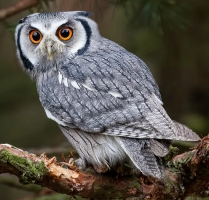 Owls are mostly solitary, and most have an upright stance, a large, broad head, binocular vision, binaural hearing, sharp talons, and feathers adapted for silent flight.
Owls are mostly solitary, and most have an upright stance, a large, broad head, binocular vision, binaural hearing, sharp talons, and feathers adapted for silent flight. Owls hunt mostly small mammals, insects, and other birds, although a few species specialize in hunting fish. They are found in all regions of the Earth except the polar ice caps and some remote islands. When owls group together, it's called a 'parliament' of owls. In most species, the smaller adult male feeds the female who is incubating the nest. Incubation begins as each egg is laid. Because it can take food away from younger nestlings, the oldest owlet is well fed even when prey populations are low. With severe famine, the parent owl may feed the smaller owlets to its larger nestmates. Owls are downy at hatching, and most species remain in or near the nest until they are able to fly. Owls have large, forward-facing eyes and ear-holes, a hawk-like beak, a flat face, and usually a conspicuous circle of feathers around each eye. The feathers making up this disc can be adjusted to sharply focus sounds from varying distances onto the owls' ear cavities. Most birds of prey have eyes on the sides of their heads, but the stereoscopic nature of the owl's forward-facing eyes permits the greater depth perception necessary for low-light hunting. Owls can rotate their heads up to 270°. Although owls have binocular vision, their large eyes are fixed in their sockets, as with most other birds, so they must turn their entire heads to change views. Owls are actually farsighted, being unable to clearly see anything within a few centimetres of their eyes. However, their far vision, particularly in low light, is exceptionally good. 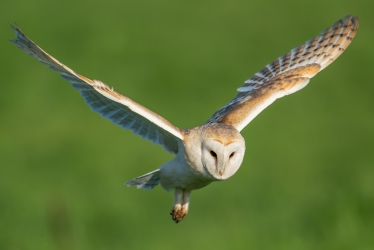 Most owls have the ability to fly almost silently and more slowly in comparison to other birds of prey. This gives them a strong advantage over prey, alert to the slightest sound in the night.
Most owls have the ability to fly almost silently and more slowly in comparison to other birds of prey. This gives them a strong advantage over prey, alert to the slightest sound in the night. Owls’ feathers are generally larger than the average birds’ feathers. The surface of the flight feathers is covered with a velvety structure that absorbs the sound of the wing moving. This maximizes the owl's ability to silently fly to capture prey without the prey hearing the owl coming. An owl's sharp beak and powerful talons allow it to kill its prey before swallowing it whole. They regurgitate the indigestible parts of their prey, such as bones, scales, and fur, in the form of pellets. These 'owl pellets' are often sold by companies to schools for dissection by students as a lesson in biology and ecology. An owl’s supposed wisdom is based on the shape of its face and large eyes, and its ability to turn its head to stare, giving the impression of undivided attention. However, it isn’t among the social birds, which are considered intelligent. These include crows, starlings and house sparrows, which have all shown problem-solving ability, and parrots, which can associate words and phrases with objects and events. Many social birds have a wide vocabulary, including calls for certain predators. Some even learn to fool their rivals by imitating predators’ calls to scare other birds away from food sources. Owls, however, don't have relatively large, well-developed brains like these social birds, don't exhibit curiosity, and when tested in captivity haven't shown above-average intelligence. Owls in Canada 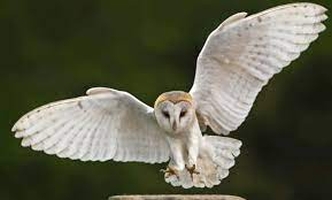 Barn Owl
Barn OwlThese owls are 35–50 cm tall, with a weight of 460 gr (1 lb). They're crow-sized with a white, heart shaped face, dark eyes and long legs. They can be found in coastal British Columbia south of Vancouver, as well as in southern Ontario, and many other places in the world; they are the most widely distributed owl in the world. Mice make up 75% of their diet. Barn Owls are strictly nocturnal, roosting during the day in cavities or farm buildings. Pairs of Barn Owls mate for life. They don't build a nest, but lay 5 to 10 white eggs directly on the floor. Their call is a long, hissing shriek. They have a lifespan of up to 17 years. 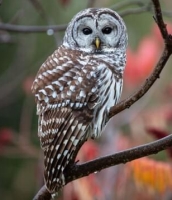 Barred Owl
Barred OwlThe Barred Owl is 42–60 cm tall, with a weight of 720 gr. They can be found in British Columbia, northern Alberta, Saskatchewan and southern Manitoba through to the Maritimes. They are gray-brown with a cross-barred neck and breast, a streaked belly, and dark eyes. They don't have ear tufts; they're often called ‘hoot owls’. They are active day or night, and can hear the squeak of a mouse from 46 metres away. Barred owls often drink and bathe in open water, even in winter, and have been seen wading into water to catch fish. Its voice is a strong 'hoo hoo ho-ho'. Both sexes incubate the two to four white eggs laid in a tree cavity. Their lifespan is up to 23 years 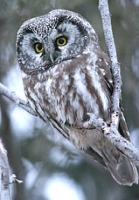 Boreal Owl
Boreal OwlThese owls are 20–30 cm tall, and weight 135 gr. They can be found in B.C. and across northern Canada. They are also called ‘Richardson’s Owl’ or the ‘Sparrow Owl’. Boreal Owls are brown with white spots above, and a rust-streaked breast, heavily spotted forehead, and a yellow bill. A dark ‘V’ pattern on their face creates an angry expression, Boreal owls do not have ear tufts. They are nocturnal, roosting in thick cover during the day. They're fearless of man; the Inuit thought their ease of being captured was because they couldn’t see in daylight. They use old woodpecker holes for nesting, laying four to six white eggs. Sometimes they will shelter in old barns. They prey on small rodents, birds and insects. Their lifespan is up to 15 years. Hear a Boreal Owl. 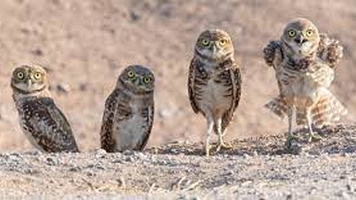 Burrowing Owl
Burrowing OwlBurrowing Owls are 23 - 27 cm tall, and weigh 155 gr. They can be found in Southern Alberta and Saskatchewan. They're a robin-sized, ground dwelling owl with long legs, a short tail and yellow eyes. They also have no ear tufts; their face is framed in white with a blackish collar. They are usually found only in grasslands or agricultural fields. Although nocturnal, they can often be seen perched on fence posts or farm machinery during the day. The sound it makes is a high, trumpeting coo coooo. They eat small rodents and insects, particularly grasshoppers, and mostly fly low to the ground. Burrowing Owls nest and roost in underground burrows lined with grass, roots and animal dung, laying 7 - 12 white eggs, the largest clutch of any North American owl. They often live in pairs or colonies in the abandoned burrows of prairie dogs or ground squirrels. Although small, they can fly at up to 19 kmh. Their lifespan is up to 11 years. Burrowing Owls are endangered because of habitat loss, and the use of pesticides on their insect prey 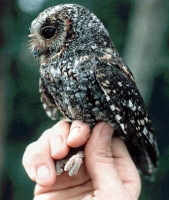 Flammulated Owl
Flammulated OwlThis tiny owl is just 15 - 17 cm tall, and weighs 60 gr. They can be found in British Columbia. It's a small owl, slightly larger than a sparrow, with small, indistinct ear tufts, reddish edges on the facial disk, and red and/or grey plumage. 'Flammulated' means having flame-shaped markings. The Flammulated Owl is the only small North American owl with dark eyes. It lives in coniferous woodlands and forest edges, and is nocturnal, roosting during the day in tree cavities, often those previously used by woodpeckers, and hunting at night for insects captured with its feet. When nesting, it lays 3 or 4 white eggs. Its voice is a low, soft poot or 'podo podo' repeated every few seconds. 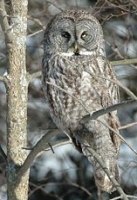 Great Grey Owl
Great Grey OwlThis large owl is 60 - 82 cm tall, and weighs just over a kilogram. They are found in the Yukon, Northwest Territories, and from British Columbia to Ontario. They're one of Canada’s largest owls, and look much heavier than they are because of their fluffy plumage, long tail and large head. The Great Grey Owl has yellow eyes, no ear tufts, and grey feathers with dark, smudgy markings. It has a black chin spot bordered by white patches like a bow tie. Its large, heavily ringed facial disc makes the eyes look small. The sound it makes is a series of up to ten deep, muffled hoots. It hunts for small mammals at night, or at dusk and dawn, and can be active during the day. The female lays 2 to 5 white eggs in a bulky stick-nest located in dense conifers. The Great Grey Owl is a very secretive bird. It's also the Provincial bird of Manitoba. 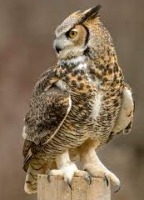 Great Horned Owl
Great Horned OwlThe Great Horned Owl is 45 - 62 cm tall, and weighs about one and a half kilograms. It can be found Canada wide. Its broad head has prominent, wide spaced ear tufts; these aren't really ears, just tufts of feathers. The ears are on the sides of the head in the usual location. This owl is grayish or brownish above, mottled and streaked underneath, with a tawny orange facial disc and white throat. However, the colour is variable, ranging from nearly white in the Arctic to dark brown and grey in the south. The sound it makes is a series of deep muffled ho hoo hoo hoododo noises. Active day or night, it's sometimes called the `winged tiger’ for its hunting ability; its flight speed can be up to 64 km/h and its prey include rabbits, skunks, and grouse. They will make use of a regular feeding post near their nest, where they will bring prey to be torn up and eaten. The Great Horned Owl has stick-nests in trees, in caves, or on the ground, laying 2 or 3 white eggs. The Great Horned Owl is the Provincial bird of Alberta. It has a lifespan of up to 29 years 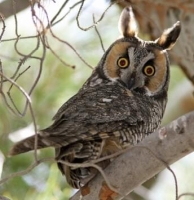 Long-eared Owl
Long-eared OwlThis owl is 32 - 40 cm tall and weighs 260 gr. It nests all across southern Canada. It's nearly crow sized, with long ear tufts set close together; it is heavily streaked and barred on the belly, with a rusty facial disc. Its long black `ears’ are actually feather tufts which are flattened against its head when it flies. The Long-eared Owl is nocturnal and usually solitary; a few may roost together in winter but they are so silent they are seldom seen. They inhabit dense deciduous and coniferous forests. A Long-eared Owl will pretend to be wounded to lure intruders away from its nest. If disturbed it will raise ear tufts and compress its feathers, to make itself look like the stub of a tree limb. The owls hunt small mammals at night, and roost next to tree trunks during the day. They emit a soft, low wooip every few seconds. Four or five white eggs are laid in a stick-nest. Their lifespan is up to 27 years. 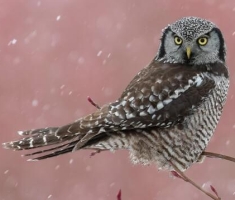 Northern Hawk Owl
Northern Hawk OwlThis 35 - 42 cm tall owl weighs 320 gr. It can be found all across northern and central Canada. The Northern Hawk owl has a black bordered facial disc, underparts that are cross barred with dark brown, a long tail, and no ear tufts. It can be found in boreal and coniferous forests, open spruce woods, and near muskeg, where it perch on tree tops or poles to watch for small mammals. The name comes from the owl's hawk-like posture and flight. It will often hover over open ground looking for prey. It is generally more active during the day than other forest owls. It's very tame, and can be approached closely. Its sound is a series of popping popopopopopo noises. It will follow farmers loading hay bales onto wagons, and pounce on uncovered mice. They also eat small mammals, birds and insects. The Northern Hawk Owl lays 3 to 7 white eggs in the hollow tops of spruce trees, tree cavities or abandoned stick-nests. 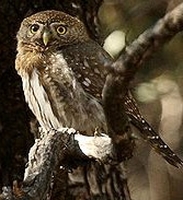 Northern Pygmy Owl
Northern Pygmy OwlThese small 17 - 20 cm tall owls weigh just 70 gr. They nest in southern British Columbia and Alberta. They are a sparrow sized owl with a small round head; the plumage is dark brown with pale bars, dark streaks and a spotted crown. Its dark head has a white ‘eyebrow’ over the eyes. Its long tail is often moved or cocked sideways when perched. It also has two black spots on the back of its neck that look like eyes. With no soft wing feathers to muffle the sound of its flight, the Northern Pygmy Owl relies on speed and agility instead of surprise. They have a ferocity and strength out of proportion for their size. This owl inhabits areas of open coniferous or mixed deciduous forest. It makes a series of toots repeated every few seconds. It likes to perch in trees to hunt for small birds; it's mainly nocturnal, but will hunt during the day. Females lay 3 to 6 white eggs in an existing tree cavity. 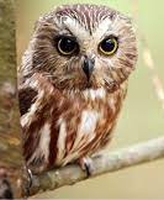 Northern Saw-whet Owl
Northern Saw-whet OwlAnother tiny owl, this one is just 17 - 20 cm tall and weighs 80 gr. It can be found across southern and central Canada. The Northern Saw-whet is actually the smallest northern owl, and is sometimes called the ‘Sparrow Owl’. Its large head has a prominent white ‘V’ on the face, and whiteish streaks; its fluffy plumage is reddish brown above, with reddish streaks on a lighter belly, and a reddish facial disc. It has yellow eyes, a dark bill, and no ear tufts. This owl lives in mixed coniferous and deciduous forests, and is active at night. It roosts in dense trees during the day. Its usual food is insects, but it will occasionally eat small rodents or birds. It emits a series of low toit toit whistled toots; its name comes from its two-note call. These are remarkably tame owls that are nearly fearless of man. They lay 5 or 6 white eggs in an existing tree cavity. Their lifespan is up to 17 years. 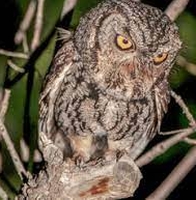 Western Otus kenicottii
Western Otus kenicottiiThese owls, also called Western Screech Owls, can be found in British Columbia, as well as southern Saskatchewan to Quebec. They are 17–25 cm tall and weigh 180 gr. Their plumage varies from brownish red to gray. These owls are small and stocky, with a large head, broad wings and a short tail. Its ear tufts are prominent when raised, and they have a flat-headed look when the tufts are down. Western Otus kenicottii are strictly nocturnal, foraging at night for insects and rodents. They roost in tree cavities during the day, and females lay 3 - 8 white eggs. They make a series of short pwep pwep pwep whistles, a soft, mournful whinny that aroused fear and suspicion among early settlers. Their lifespan is up to 13 years. 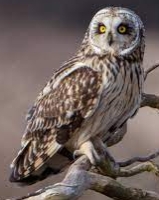 Short-eared Owl
Short-eared OwlThese owls are 32 - 42 cm tall and weigh 350 gr. They nest across Canada in grassland areas. The Short-eared Owl is crow-sized and slender, with barely visible ear tufts. It is tawny brown overall, with a heavily streaked underside and a dark triangle around each eye. This long-winged owl likes open country, marshes and tundra. It has a high pitched, rasping call like the bark of a small dog, a muffled poo poo poo in a quick series They will fly low over the ground at a speed of up to 42 kmh and hover briefly, before swooping down on rodents and small mammals. They roost on the ground, occasionally in large groups; they're a lot more gregarious in winter, and may gather where prey is abundant. The Short-eared Owl is less nocturnal than other owls and is often seen in daylight. Adults will perform the 'crippled bird' act to lure intruders from their nest. 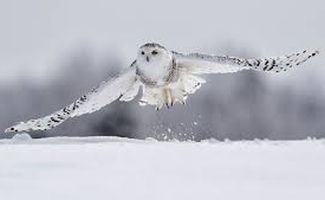 Snowy Owl
Snowy OwlThese large owls stand 50–67 cm tall and weigh up to 1.8 kg. They can be found in the far north regions of Canada. In the non-breeding season, this species also can be found in areas of southern Canada and the northern United States. They have the most northerly distribution of any owl. The Snowy Owl is Canada's heaviest owl, with a flight speed of 80 km/h. It is mostly white, with yellow eyes; old males may be pure white. This owl is completely encased in feathers, from its toes and foot pads to the tip of its beak. It is often seen perching on fence posts or poles. It's most active at night, hunting small rodents and birds. The Snowy Owl requires a very large territory, up to 10 sq km, due to the scarcity of prey in the north. Its hoots can be heard more than 3 km away. If rodents are abundant, the female will lay up to 13 eggs in a shallow ground depression lined with feathers. The Snowy Owl is the Provincial bird of Quebec. It has a lifespan of up to 14 years 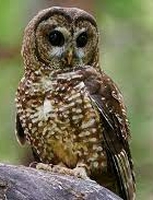 Spotted Owl
Spotted OwlThis owl stands 40–47 cm tall and weighs 610 gr. It can be found in southwestern British Columbia. It is a large, round-headed owl with white spotting on its head, back and underparts, and has dark eyes. It prefers to live in canyons and humid forests of coniferous trees; it's strictly nocturnal, and is seldom seen. One of its calls is similar to that of a baying hound; its voice is a strong, rhythmic hooting whup hoo hoo hoooo Pairs mate for life. The female lays 2 - 3 white eggs on the bare floor of a tree cavity. Their home range can be as much as 2,500 acres. The Spotted Owl preys on small rodents, birds and insects; this species of owl is very endangered due to loss of first growth forest habitats. 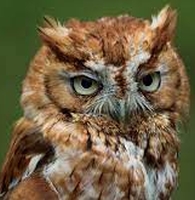 Eastern Screech Owls
Eastern Screech OwlsThe Screech Owl is a very common species throughout the southern regions of eastern Canada, and has a tendency to frequent urban areas. Nest trees are regularly felled in spring by storms or people, leaving behind orphaned owlets. Adults are often hit by cars while hunting near roads (there are more mice near the roads because of the garbage in ditches) and survivors commonly incur permanent eye or neurological injuries, making them unreleasable even if they are rescued. Screech Owls are often confused with young Great Horned Owls because both species have conspicuous ear tufts. In addition, the Western Screech Owl and the Eastern Screech Owl were considered the same species until the 1970’s; they can be distinguished by their different vocal calls. The Eastern Screech Owl is one of Canada's smaller owl species. Their mottled feathering camouflages their slender bodies as they perch on trees. This owl probably gets its name from the screeching call it gives when scared. Its courtship call resembles the "hoooOOOooo" people associate with ghostly sounds. Eastern Screech Owls will also produce single hoot when surprised. |